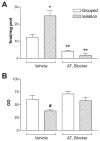Angiotensin II AT1 receptor blockade prevents the hypothalamic corticotropin-releasing factor response to isolation stress
- PMID: 17306778
- PMCID: PMC2682713
- DOI: 10.1016/j.brainres.2007.01.037
Angiotensin II AT1 receptor blockade prevents the hypothalamic corticotropin-releasing factor response to isolation stress
Abstract
Sustained pretreatment with angiotensin II AT(1) receptor antagonists prevents the sympathoadrenal and hormonal responses to 24 h isolation stress. To elucidate the mechanism of the anti-stress effects of AT(1) receptor antagonism, we examined the effect of subcutaneous infusion of candesartan, a non-competitive AT(1) receptor antagonist, 0.5 mg/kg/day for 14 days, to Wistar rats on the hypothalamic pituitary adrenal (HPA) axis after 24 h isolation stress. In the morning of day 15, we measured AT(1) receptors corticotropin-releasing factor (CRF) mRNA and immunoreactive CRF in the paraventricular nucleus (PVN), the pituitary adrenocorticotropin hormone (ACTH) and adrenal corticosterone content, and the urinary corticosterone excretion. In rats not treated with candesartan, 24 h isolation stress increased pituitary ACTH, adrenal corticosterone content and AT(1) receptor binding in the PVN but decreased CRF mRNA and CRF content in the PVN. This indicates enhanced CRF utilization not compensated by CRF gene transcription and effective glucocorticoid feedback inhibition in spite of the increase in AT(1) receptor expression. The effects of stress on HPA axis activation and CRF mRNA and content in the PVN were prevented by candesartan pretreatment, suggesting that activation of AT(1) receptors is required for the HPA axis response to isolation. Our results support the hypothesis that the activity of PVN AT(1) receptors is part of the mechanism necessary for development of a full stress-induced HPA axis activation. Inhibition of central AT(1) receptors limits the CRF response to stress and should be considered as a therapeutic tool to preserve homeostasis under chronic stress conditions.
Figures






References
-
- Aguilera G. Factors controlling steroid biosynthesis in the zona glomerulosa of the adrenal. J Steroid Biochem Mol Biol. 1993;45:147–151. - PubMed
-
- Aguilera G. Regulation of pituitary ACTH secretion during chronic stress. Front Neuroendocrinol. 1994;15:321–350. - PubMed
-
- Aguilera G, Harwood JP, Wilson JX, Morell J, Brown JH, Catt KJ. Mechanisms of action of corticotropin-releasing factor and other regulators of corticotropin release in rat pituitary cells. J Biol Chem. 1983;258:8039–8045. - PubMed
-
- Aguilera G, Kiss A, Luo X. Increased expression of type 1 angiotensin II receptors in the hypothalamic paraventricular nucleus following stress and glucocorticoid administration. J Neuroendocrinol. 1995a;7:775–783. - PubMed
-
- Aguilera G, Young WS, Kiss A, Bathia A. Direct regulation of hypothalamic corticotropin-releasing-hormone neurons by angiotensin II. Neuroendocrinology. 1995b;61:437–444. - PubMed
Publication types
MeSH terms
Substances
Grants and funding
LinkOut - more resources
Full Text Sources
Medical
Research Materials

